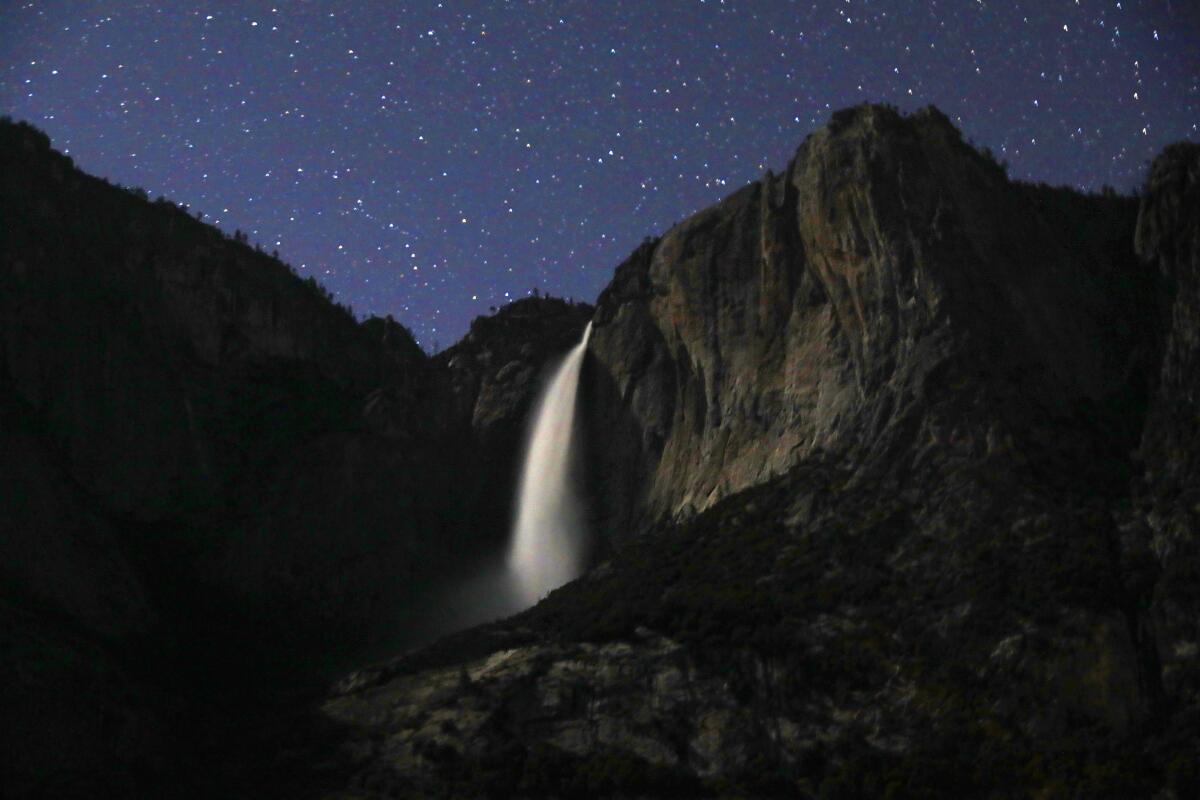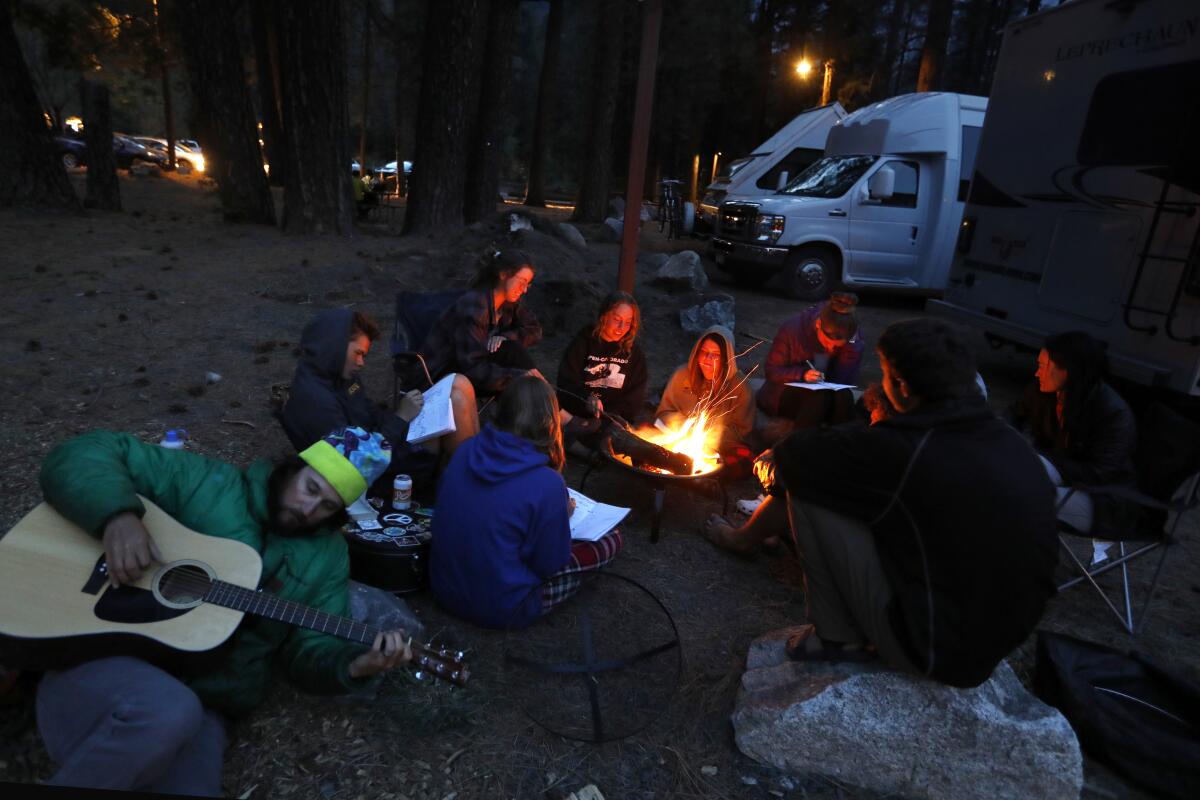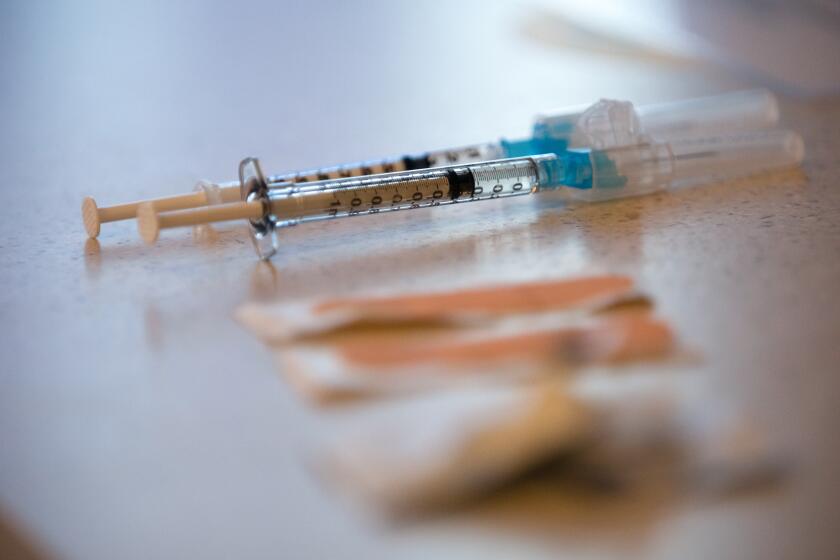Coronavirus Today: J&J vaccine pause lifted
Good evening. I’m Melody Petersen, and it’s Friday, April 23. Here’s the latest on what’s happening with the coronavirus, plus ways to spend your weekend and a look at some of the week’s best stories.
The U.S. Food and Drug Administration and the U.S. Centers for Disease Control and Prevention rescinded their pause on the use of Johnson & Johnson’s COVID-19 vaccine Friday, clearing the way for states to resume immunizations with the single-dose shot.
The decision came just hours after a federal advisory panel recommended that immunizations with the J&J vaccine be resumed despite a tiny risk of blood clots, writes my colleague Melissa Healy.
Federal officials recommended the pause 10 days ago, after six cases of a rare and perplexing clotting disorder were found among those getting the shots. All six cases involved women ages 18 to 48.
The number of cases rose to 15 when safety experts went back and reviewed records of adverse reactions to the vaccine. All of those cases were in women, and all but one were under 50.
Even so, the advisory panel said the risk was still tiny — effectively 1.9 cases per million people in the general population, or 7 cases per million women under 50. Federal scientists agreed.
“The FDA and CDC have confidence that this vaccine is safe and effective in preventing COVID-19,” the agencies said in a joint statement, adding that they “will remain vigilant in continuing to investigate this risk.”
Federal teams have reached out to doctors around the country to make sure they know how to recognize and treat the rare clotting disorder, which the agencies called thrombosis-thrombocytopenia syndrome, or TTS.
Los Angeles County officials said the decision cleared the way for them to resume use of the shots as early as Saturday. “We don’t want to delay,” said Dr. Paul Simon, chief science officer for the county’s public health department.
The pause in J&J shots had little effect on California’s vaccination campaign, since most of the state’s shipments were of the vaccines made by Pfizer-BioNTech and Moderna. L.A. County officials recently reported administering a weekly average of nearly 100,000 doses per day.
Some county vaccination sites are now for a limited time taking those who don’t have appointments. County officials did not say how many spots would be available each day, and it was not immediately clear whether walk-up availability would last beyond Monday.
In some other parts of the country, demand for the shots has plummeted. Some officials are finding that they need to turn down shipments.
Louisiana has stopped asking the federal government for its full allotment of vaccine. About three-quarters of Kansas counties have turned down new shipments at least once over the past month. And in Mississippi, officials asked the federal government to ship vials in smaller packages so doses don’t go to waste.
Robin Jackson, a small-town pharmacist there, has resorted to practically begging anyone in her community to get shots, even after placing signs outside her storefront celebrating a shipment’s arrival.
“Nobody was coming,” she said. “And I mean no one.”
She might find demand for some of those unused doses on Mt. Everest, now that the coronavirus has landed on the world’s tallest mountain.
A Norwegian climber became the first to test positive in the base camp there. He was flown by helicopter to Kathmandu, Nepal, and hospitalized with COVID-19.
Erlend Ness said he tested positive on April 15. He said another test on Thursday was negative, and he was now staying with a local family in Nepal.
Ace mountain guide Austrian Lukas Furtenbach warned that the virus could spread among the hundreds of other climbers, guides and helpers who are now encamped on the base of Everest. He said there could be more than one case on the mountain because Ness had lived with several others for weeks.
“We would need now most urgently mass testing in base camp, with everyone tested and every team being isolated — no contact between teams,” he said. “That needs to be done now. Otherwise, it is too late.”
By the numbers
California cases and deaths as of 5:30 p.m. Friday:

Track California’s coronavirus spread and vaccination efforts — including the latest numbers and how they break down — with our graphics.

See the current status of California’s reopening, county by county, with our tracker.


What to read this weekend
COVID-19 canceled their football season. That’s when they got creative
It was the first week of March, and the Trinity High School Wolves were at long last practicing football after a season upended. State health officials had just given their blessing for an abbreviated spring football season, and in Weaverville, a Northern California logging town of 3,100 people, the overjoyed team was practicing six days a week.
There was just one problem: The Wolves’ far-flung league, which includes rural schools across county lines, had already been canceled. So Trinity High got creative. They would play one game. They would split their own team in half, play themselves, and fill the stands. It would be homecoming — their way.

For some, returning to pre-pandemic life is tougher than expected
Shelby Bernstein can’t wait for life to get back to normal. But as COVID-19 restrictions are lifted across L.A. County, Bernstein has found herself feeling increasingly anxious. “Maybe it’s like Stockholm syndrome, except our captor is the coronavirus,” she said. “We’re all so used to the mental and physical havoc it wreaked upon us that any sense of normalcy feels wrong.”
Some people have jumped at the chance to see movies in actual theaters, grab a drink at a bar with friends, cheer the Dodgers or attend a small dinner party with fully immunized friends. Yet for others — even some who are fully vaccinated — the fear that any relaxation of safety protocols will lead to another surge is hard to shake.
A hungry insect feasts in the darkened Getty
Last March, as the lights went off in museums across California and galleries were shuttered in the first wave of coronavirus closures, an invader penetrated the Getty Museum. It crept into the darkened, quiet decorative arts galleries filled with ornate furniture, intricately woven tapestries and ancient rugs.
The interloper: the webbing clothes moth, which feeds on silk, wool and other organic material. And so began Project Moth Remediation, for which a fleet of workers at the museum was mobilized to clear the galleries of insects and fend off future ones.
At the start of the pandemic, “we thought, ‘Oh, what a wonderful opportunity to save electricity and not expose things to light,’” said Jane Bassett, the Getty’s senior conservator for decorative arts. “But these guys love hiding in the dark.”

Five L.A. poets on life beyond the pandemic
At dozens of cafes, libraries and bookstores, Southern California teemed with poetry readings and open-mic nights before COVID-19 took hold. Some of these events managed to survive by migrating online. Others have been lost for good.
We asked five poets to reflect on the confinement and share their hopes for what lies ahead. Though disparate in background, style and subject matter, these poets share an unwavering — though not romanticized — love for the place we call home.
Your support helps us deliver the news that matters most.
What to do this weekend
Get outside — and enjoy nature. We’ve found five little-known nature preserves not far from L.A. Or add native plants to your garden to attract bees, hummingbirds and butterflies. Subscribe to The Wild for more on the outdoors.
Watch something great. Our weekend culture watch list includes “Trouble in Tahiti,” Leonard Bernstein’s one-act musical drama about an unhappily married couple in post-World War II suburbia. The performance makes the Pacific Opera Project the first of L.A.’s larger performing arts companies to open an in-person show this weekend. And in his Indie Focus newsletter’s roundup of new movies, Mark Olsen writes about “Stowaway,” the story of a space mission whose crew discovers an extra passenger aboard their ship; it is streaming now on Netflix. Also don’t forget the Oscars are on Sunday. Our awards columnist has predictions in all 23 categories.
Eat something great. Jenn Harris writes that L.A. is in the midst of a chile sauce craze, and she offers 16 to try. Plus in the latest Tasting Notes newsletter, Bill Addison writes of what some of L.A.’s gifted pastry chefs have done to survive the pandemic and where you can buy their cakes.
Go online. Here’s The Times’ guide to the internet for when you’re looking for information on self-care, feel like learning something new or interesting, or want to expand your entertainment horizons.
The pandemic in pictures

It was a year ago that Yosemite National Park closed its gates, thanks to the COVID-19 pandemic, and the animals took over. Campgrounds were left empty, and the trails were devoid of people.
One year later, the stars are out, the crowds are back and, well, the animals, they’re just chillin’.
Currently, the park’s target is to allow about 50% of the average June vehicle entry rate, which equates to 3,600 vehicle entries each day. Reservations will be required to drive into Yosemite beginning May 21. Some services and facilities are limited, and shuttles are not operating.

Resources
Need a vaccine? Sign up for email updates, check your eligibility and, if you’re eligible, make an appointment where you live: City of Los Angeles | Los Angeles County | Kern County | Orange County | Riverside County | San Bernardino County | San Diego County | San Luis Obispo County | Santa Barbara County | Ventura County
Practice social distancing using these tips, and wear a mask or two.
Watch for symptoms such as fever, cough, shortness of breath, chills, shaking with chills, muscle pain, headache, sore throat and loss of taste or smell. Here’s what to look for and when.
Need to get tested? Here’s where you can in L.A. County and around California.
Americans are hurting in many ways. We have advice for helping kids cope, resources for people experiencing domestic abuse and a newsletter to help you make ends meet.
We’ve answered hundreds of readers’ questions. Explore them in our archive here.
For our most up-to-date coverage, visit our homepage and our Health section, get our breaking news alerts, and follow us on Twitter and Instagram.




